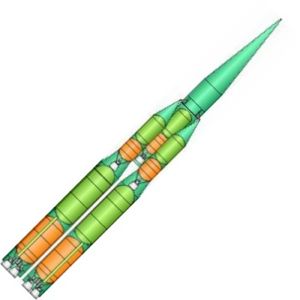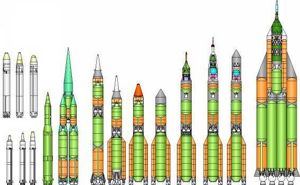Initial UR-500 (original) (raw)

Home - Search - Browse - Alphabetic Index: 0- 1- 2- 3- 4- 5- 6- 7- 8- 9
A- B- C- D- E- F- G- H- I- J- K- L- M- N- O- P- Q- R- S- T- U- V- W- X- Y- Z
Initial UR-500

UR-500 First Design
Initial design of the UR-500 Global Rocket was a straightforward cluster of UR-200 ICBM's. This was soon abandoned in favour of a more efficient design.
Credit: © Mark Wade
While Chelomei's OKB was still preparing the UR-200 draft project, it was proposed to use this as the basis for the UR-500 heavy universal rocket, with five times the payload capacity. These initial 1961 studies consisted of 4 two-stage UR-200 rockets lashed together, the first and second stages working in parallel in clusters. A third stage would be modified from the UR-200 second stage. However analysis indicated that the payload capacity could not meet the military's requirements.
Status: Design 1962. Payload: 10,000 kg (22,000 lb). Thrust: 7,994.70 kN (1,797,280 lbf). Gross mass: 571,050 kg (1,258,940 lb). Height: 48.00 m (157.00 ft). Diameter: 3.00 m (9.80 ft). Apogee: 200 km (120 mi).
The design was in response to the military GR-2 global rocket requirement for a booster that could orbit six multiple nuclear warheads. A subscale dynamic test article of the design was preserved in the Tsniimash museum. An echo of this configuration in the final Proton design was in the upper stage engines, which were direct descendants of those on the UR-200. The payload was said to be 10,000 kg as opposed to the 12,000 kg for the selected UR-500 polyblock configuration.
LEO Payload: 10,000 kg (22,000 lb) to a 200 km orbit.
Stage Data - Initial UR-500
- Stage 1. 4 x UR-200 Stage 1. Gross Mass: 107,500 kg (236,900 lb). Empty Mass: 6,600 kg (14,500 lb). Thrust (vac): 2,235.000 kN (502,447 lbf). Isp: 311 sec. Burn time: 135 sec. Isp(sl): 278 sec. Diameter: 3.00 m (9.80 ft). Span: 3.00 m (9.80 ft). Length: 20.00 m (65.00 ft). Propellants: N2O4/UDMH. No Engines: 1. Engine: RD-0202. Other designations: 8K81 Stage 1. Status: Out of production. Comments: Tsniimash has 1:10 structural simulation model. Developed 1960-1965. Orevo has sectioned hardware. All data accurate except empty mass prorated between first and second stages.
- Stage 2. 4 x UR-200 Stage 2. Gross Mass: 25,810 kg (56,900 lb). Empty Mass: 2,400 kg (5,200 lb). Thrust (vac): 612.900 kN (137,785 lbf). Isp: 322 sec. Burn time: 113 sec. Diameter: 2.20 m (7.20 ft). Span: 2.20 m (7.20 ft). Length: 10.00 m (32.00 ft). Propellants: N2O4/UDMH. No Engines: 1. Engine: RD-0205. Other designations: 8K81 Stage 2. Status: Out of production. Comments: Tsniimash has 1:10 structural simulation model. Developed 1960-1965. Orevo has sectioned hardware. All data accurate except empty mass prorated between first and second stages.
- Stage 3. 1 x UR-200 Stage 2. Gross Mass: 25,810 kg (56,900 lb). Empty Mass: 2,400 kg (5,200 lb). Thrust (vac): 612.900 kN (137,785 lbf). Isp: 322 sec. Burn time: 113 sec. Diameter: 2.20 m (7.20 ft). Span: 2.20 m (7.20 ft). Length: 10.00 m (32.00 ft). Propellants: N2O4/UDMH. No Engines: 1. Engine: RD-0205. Other designations: 8K81 Stage 2. Status: Out of production. Comments: Tsniimash has 1:10 structural simulation model. Developed 1960-1965. Orevo has sectioned hardware. All data accurate except empty mass prorated between first and second stages.
Family: orbital launch vehicle. Country: Russia. Engines: RD-0205, RD-0202. Stages: UR-200-2, UR-200-1. Agency: Chelomei bureau.
Photo Gallery
 |
UR-100 and UR-500UR-100 and UR-500 Dynamic test modelsCredit: © Mark Wade |
|---|
1961 During the Year - . LV Family: Proton. Launch Vehicle: Initial UR-500.
- Initial UR-500 studies for the GR-2 requirement - . Nation: Russia. The initial design consisted simply of 4 two-stage UR-200 rockets lashed together, the first and second stages working in parallel in clusters. A third stage would be modified from the UR-200 second stage..
Home - Search - Browse - Alphabetic Index: 0- 1- 2- 3- 4- 5- 6- 7- 8- 9
A- B- C- D- E- F- G- H- I- J- K- L- M- N- O- P- Q- R- S- T- U- V- W- X- Y- Z
© 1997-2019 Mark Wade - Contact
© / Conditions for Use
